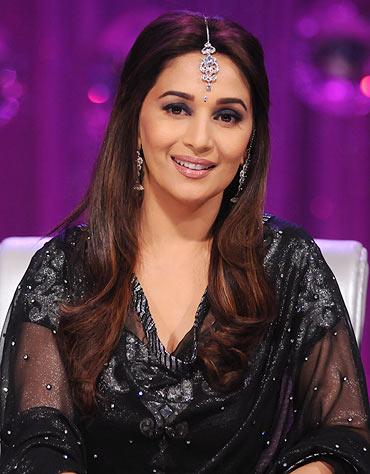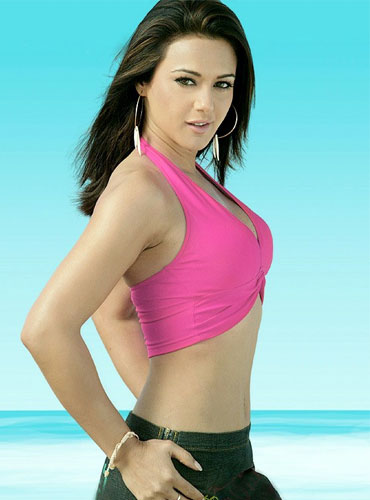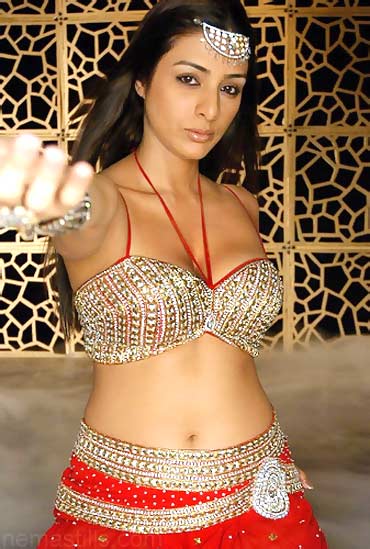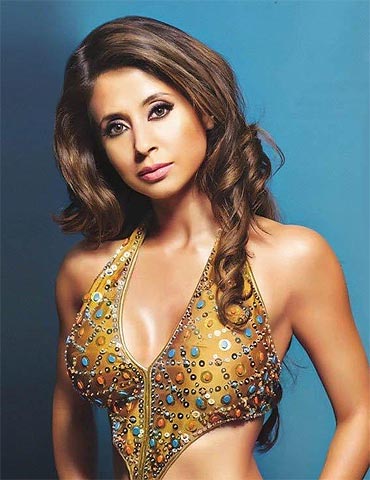Sukanya Verma in Mumbai
It's one of the saddest facts of Bollywood. But when it comes to longevity, a heroine's shelf life is nowhere close to that of her hero. While the latter is never too old or silly to romance heroines half his age, it's considered inappropriate if an actress follows suit.
If it's not her age, then much hue and cry is made about her (supposedly) fading star power, post-marriage or motherhood. Considering these stereotypical mindsets, the last decade marked winds of progression with married actresses continuing to reign and hitting 30 wasn't a cause for depression.
Moreover, gone are the days of raw, gawky young ladies, the spunky new batch featuring Sonam Kapoor, Deepika Padukone, Anushka Sharma and Kangna Ranaut, etc, is a well-prepped picture of poise, polish and pizzazz.
Quite a coming-of-age for the Hindi film heroine, no? In our second installment of the end-of-the-decade special, we profile the career graph of our top 10 actresses in the last 10 years.
Aishwarya Rai Bachchan
Apart from that weighty addition to her name after she tied the knot to Guru co-star Abhishek Bachchan, Aishwarya Rai emerged as a international star featuring on the cover of Time magazine, interviewed by Oprah Winfrey and David Letterman, became the only Bollywood heroine to be immortalized in wax at Madame Tussauds and the first Indian actor invited to be on the Cannes jury before she became a regular fixture at the temple.
Before that, she had her share of heartbreak and red carpet disasters too.
The year opened with promise courtesy author-backed roles in big-banner fare like Josh, Hamara Dil Aapke Paas Hai, Kandukondain Kandukondain, Dhaai Akshar Prem Ke and a special appearance in Mohabbatein.
It was her resplendent rendition of Paro in Sanjay Leela Bhansali's Devdas (2002), however, that won maximum acclaim. But she couldn't follow it up with a worthy act instead the only notable aspect of her career was a sexy jig along with Shah Rukh Khan in Shakti's Ishq Kamina (2002).
Things looked up slightly with Ash making efforts to expand her range working in regional and international projects like Rituparno Ghosh's Chokher Bali (2003) and Raincoat (2004), and Gurinder Chadha's Bride and Prejudice (2004), The Mistress of Spices (2005). Instead, it was her sly, negative role in Khakee (2004) that got a better reception.
The next phase in her career saw Ash oscillating between women-oriented dramas like Provoked, Umrao Jaan (2006) and dishy leading lady of potboilers like Dhoom 2 (2006), or breaking into a sizzling Kaja re in Bunty Aur Babli (2005).
Though her international stint was laden with turkeys like The Last Legion (2007) and Pink Panther 2 (2009), Ash didn't have much to worry thanks to the box office and critical appreciation of Guru (2007) and Jodhaa Akbar (2008).
2010 ended on a exhaustive note with only one out her four hyped biggies Endhiran/Robot, Action Replayy, Raavan/Raavanan and Guzaarish hitting its blockbuster target.
Kajol
Image: KajolSince her marriage to Ajay Devgn in 1999 and becoming mother to two kids Nysa (2003) and Yug (2010), Kajol keeps an easy-going profile taking breaks in between signing on select films.
The new millennium saw her in hubby's poorly-received home production Raju Chacha. Her contrasting twins in Kuch Khatti Kuch Meethi (2001), a remake of Disney's The Parent Trap, didn't fare any better. The same year she made Kabhi Khushi Kabhie Gham with Karan Johar. Infusing charm and vivacity in the excessively chatty, boisterous girl from Chandni Chowk, Kajol made quite an impression.
After a five-year gap, discounting a fleeting appearance in Kal Ho Naa Ho's Mahi ve, Kajol returned to the movies opposite Aamir Khan in Kunal Kohli's superfluous romance drama, Fanaa (2006). The film was a huge success and everyone was much too happy to see their favourite actress back on screen to crib.
In 2008, she essayed an Alzheimer's patient evoking a image of vulnerability and helplessness in Devgn's directorial debut, U, Me Aur Hum. Despite rave reviews for her work, the melodrama tanked at the BO.
The year ended with three Kajol starrers, My Name is Khan, We Are Family and Toonpur Ka Superrhero. Despite expectations and the usually reliable powerhouse performer, none of them turned out to be as hard-hitting as they one thought. Though MNIK made its money, We are Family, an official remake of Hollywood's Stepmom, was a non-starter. Toonpur Ka Superrhero, which had some live animation as well, failed at the box office too.
Madhuri Dixit
Image: Madhuri DixitPretty much like Kajol, Madhuri got married and concentrated on starting a family, having shifted base to USA. Even so, the decade got a few glimpses of the star with the million-dollar smile returning every now and then for a movie or television show.
It was her grey, mildly obsessive, jilted lover act in Rajkumar Santoshi's Pukar that marked the beginning of 2000 followed by a myriad of characters in M F Husain's eclectic and quirky, Gaja Gamini.
Apart from sporting elaborate Ritu Beri outfits in 2001's Yeh Raaste Hain Pyaar Ke, the silly movie or her badly-written character did nothing for the actress. She was much more irreverent and hard-hitting as an unmarried, pregnant actress in Santoshi's flawed but engaging take on various facets of the Indian woman, Lajja.
Her poetic portrayal of Chandramukhi in Bhansali's Devdas (2002), after the unintentionally hilarious Hum Tumhare Hain Sanam, appeared to be Madhuri's glorious goodbye to celluloid. Everyone admired this performance and she won all the awards in town.
A five-year sabbatical from films finally came to an end with Yash Raj's Aaja Nachle. The dance-filled musical starring Madhuri as a choreographer and play director was touted as the ideal comeback but failed to create any ripples.
At the end of 2010, the actress hit the Indian shores to judge the dance-based reality show, Jhalak Dikhhla Ja.
Kareena Kapoor
Image: Kareena KapoorThe beginning of this decade witnessed quite a few promising newcomers but none as natural and nuanced as Kareena Kapoor.
Randhir and Babita Kapoor's youngest daughter and Karisma Kapur's baby sister, Bebo made an impressive debut opposite Abhishek Bachchan in Refugee. Irrespective of whether the film worked or not, Kareena stood out with her uninhibited performances in films like Asoka, Mujhe Kuch Kehna Hai and Ajnabee.
The big breakthrough came with K3G (2001) in which she played the super stylish, annoyingly vain but adorable Poo. Unfortunately, the Poo story didn't stop her with the actress repeating her performance in film after film to loud results and box office bombs Mujhse Dosti Karoge, Khushi and Main Prem Ki Diwani Hoon.
It took a complete makeover as a gaudy streetwalker in Chameli (2003) for Kareena to break out of the one-dimensional roles. The 'well done' streak continued with her subdued, real performances in Dev and Yuva (2004), despite their non-hit status.
There was hardly anything memorable about her resume in 2005 and most of 2006 with contrived fare like Kyon Ki, Bewafaa, 36 China Town and Chori Chori.
Things remained status quo till Vishal Bhardwaj's Omkara hit the marquee. The actress came into her own as the pristine white Dolly and followed it up with a career-best as the talkative, lively, bindaas Geet in Imtiaz Ali's Jab We Met (2007). Even as her career attained a new high, her personal life break-up with Shahid Kapoor and hook-up with Saif Ali Khan and obsession with size zero, garnered unprecedented coverage.
While her choice of movies continues to range from interesting to objectionable, Kareena has mastered the art of balancing blockbusters (3 Idiots, Golmaal movies) with bloopers (Main Aur Mrs Khanna, Kurbaan, Milenge Milenge, We are Family).
Priyanka Chopra
Image: Priyanka ChopraIt wasn't the best of starts for the winner of the coveted Miss World beauty pageant.
Priyanka Chopra's obvious choice to do movies resulted in her debut in the Tamil flick, Thamizhan.
Next, PC hit Bollywood with a vengeance whilst agreeing to play second fiddle in Sunny Deol-Preity Zinta starrer The Hero: Love Story of a Spy. Andaz, co-starring Akshay Kumar and fellow beauty queen Lara Dutta, too limited her to the supporting actress category.
2004 appeared to be doomed with disasters like Plan, Kismat and Asambhav but the timely success of Mujhse Shaadi Karoge and a well-received vamp-ish avatar in Aitraaz tossed the ball in Priyanka's court. And while there were bad choices galore, the star pitched in a big hit every now and then Waqt, Bluffmaster (2005), Krrish and Don (2006), to steer clear from trouble.
Recognition as an actress, National award-winning one at that, came in the garb of Madhur Bhandarkar's fairly engaging Fashion (2008). As an ambitious model in a hurry to get to the top, Priyanka displayed an interesting mix of edge and control.
The same year, she flaunted her hot curves and trendy Miami street style in the hit comedy, Dostana. Exploring her range as an actress, 2009 witnessed her in 12 different avatars for Ashutosh Gowariker's What's Your Raashee? but won unanimous applause for her brief but breathtaking bit as Sweety in Vishal Bhardwaj's Kaminey.
Too bad 2010 wasn't all that happening with inconsequential rom-coms like Anjaana Anjaani and Pyaar Impossible.
Rani Mukerji
Image: Rani MukerjiA hard-working actress with tremendous screen presence, the decade saw Rani emerge, peak and falter.
If the early few years recognised her versatile talent in Hey! Ram and Bichhoo, box office realised her worth through hits like Har Dil Jo Pyaar Karega and Chori Chori Chupke Chupke.
With her vibrant portrayal of Suhaani in Saathiya (2002), Rani came into her own creating her own niche through meaty and fiery parts in Chalte Chalte, Yuva, Hum Tum and Veer Zaara.
2005 turned out to be rather precious for the light-eyed star. Playing a severely handicapped Michelle McNally in Black won Rani huge respect and admiration as a keen actress with an eye for detail. In complete contrast, she played a plucky con-woman in Bunty Aur Babli. Even though her part in Paheli wasn't high on histrionics, Rani looked her best and portrayed her Lachchi with dazzling aesthetics.
Unfortunately, the going was not so good after that. Her fondness for soppy melodramas and refusal to get out of the Yash Raj comfort zone resulted in a series of flops like Baabul, Ta Ra Rum Pum, Laaga Chunari Mein Daag and Thoda Pyaar Thoda Magic. Even though Kabhi Alvida Na Kehna made its money, Rani earned flak for her soulless performance.
2009's Dil Bole Hadippa, in which she plays a girl parading as a Sardar boy for the love of cricket, was expected to change things for the better but did not. Nonetheless, the decade ended on an optimistic note as her gutsy portrayal of an investigative journalist in 2011's No One Killed Jessica generated major buzz.
Preity Zinta
Image: Preity ZintaIt all started out Preity perfect. Right from the onset, Preity Zinta signed up to play author-backed roles in films like Kya Kehna and Chori Chori Chupke Chupke. Her trademark effervescence won her a huge fan-following while her care-a-damn attitude made her a darling of the press.
Although 2001's Dil Chahta Hai was mostly about male bonding, PZ stood out with her radiance and effortless simplicity.
Despite the hideous wig and Armaan's calamitous collections, the perky star earned brownie points for her spiffy portrayal of an obsessive, spoilt brat. Also, she more than made up for that flop with two of the greatest hits of her career --Kal Ho Naa Ho and Koi... Mil Gaya (2003).
After sporting sport hairstyles that every girl wanted to copy, PZ sported a clumsy wig to play a no-nonsense TV journalist in Farhan Akhtar's Lakshya (2004). Despite a spirited performance, the film wasn't the success one had hoped it to be. Again, she made it up with her classic act in Veer-Zaara and slick city girl in Salaam Namaste and their collective bumper box office.
Post-KANK, however, things have not looked too bright for the cheerful star. Apart from owning Kings XI Punjab at the Indian Premier League, Preity hasn't done anything since indies like The Last Lear and her not-so-happening item song in Main Aur Mrs Khanna.
Tabu
Image: TabuTo think she began the year with so many possibilities. Tabu's compelling work in women-oriented dramas like Astitva (2000) and Chandni Bar (2001) not only reaffirmed her status as one of the best actresses of her generation but fetched her awards too.
That she had to spoil the picture by signing on tripe like Maa Tujhe Salaam, Hawa and Jaal: The Trap is another matter.
Things looked up with the arrival of Meenaxi and Maqbool. While M F Husain's whimsical musical was predictably a short-lived box office story, Vishal Bhardwaj's retelling of Shakespeare's Macbeth showcased the Tabu we admire and adore.
Shrugging the acclaim, the actress again went into a hibernation to resurface in bit roles of commercial fare like Fanaa and Hera Pheri. All was soon forgotten after one viewing of her intricate and beautiful performance in Mira Nair's The Namesake.
And even though R Balki's Cheeni Kum was mostly a Amitabh Bachchan vehicle, it allowed Tabu the opportunity to not shoulder an entire film and just keep it all impish and charming.
The decade ended with a super bland Toh Baat Pakki making her fans wonder why she takes such long breaks if she's planning to be this indifferent in her movie choices.
Bipasha Basu
Image: Bipasha BasuNot every star wants to play the bad girl in her debut. But the supermodel-turned-actress is quite a sport like that. Her Ajnabee (2001) is a prime example.
But it was her stuck-to-her-guns wifey in Vikram Bhatt's ghost fest, Raaz (2002) that brought her to everyone's notice considering the film was a huge hit and Bips walked away with all the credit.
A few blah films followed until Pooja Bhatt's Jism (2003) further cemented her sex-symbol-with-a-spunk image. A tad complacent about her career, Bipasha put on oodles of weight, which the indiscriminating camera was only too willing to capture. Undeterred by the unending row of flops and flak, she hit the gym with a plan. A plan to succeed. Her seductive romp in No Entry (2005) stole a march over the other female stars of the comedy and she was back in the game.
2006 was a turning point. On one hand, she emerged as a strong performer with Corporate, on the other she sizzled the screen with her bronzed bikini body in Dhoom 2 as well her electrifying dance number, Beedi in Omkara.
The good run continued with hits like Race and Bachna Ae Haseeno (2008). By the end of the decade, Bipasha refused to be tied down by her glamorous image and displayed an eagerness to keep it real through films like Lamhaa and Aakrosh.
Urmila Matondkar
Image: Urmila MatondkarShe rocked the 1990s with her pep and show while taking the Bollywood fashion scene by storm. A trendsetter by all means, Urmila Matondkar entered the '00s with the intention of breaking ground. And for a while, she did just that.
In mentor Ram Gopal Varma's Jungle, she scored a hit and followed it up with a fiercely glamorous albeit twisted character in Pyaar Tune Kya Kiya. Her bob hair and intense acting both earned thumbs up.
Although there was nothing remarkable about her role in 2002's Deewangee, it's always good to be a part of a hit. While her performance in 2003's partition drama Pinjar and spooky thriller Bhoot were on the impressive side, only the latter hit box office bull's eye.
The trend was more or less with most of her subsequent films. Despite a noteworthy performance and unique storyline, none of them Maine Gandhi Ko Nahin Maara, Naina, Ek Hasina Thi, Tehzeeb, Bas Ek Pal, Banaras -- worked at the box office.
Her efforts to do a Simi Garewal in a dreadful remake of Subhash Ghai's Karz or recreate the oomph of Helen in Ram Gopal Varma Ki Aag's Mehbooba, too, fetched her more brickbats than bouquets.











Comment
article